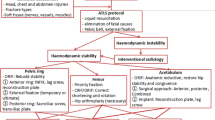Abstract
In floating hip injuries, the priority of the steps in fixation has not been well described. We have treated these patients in accordance with the following protocols. In patients with pelvic ring fractures, the external fixation should be performed first, and in patients with acetabular fractures, the femoral fractures should be internally fixated first. The purpose of the present study was to review our experience with these fracture treatments to evaluate our strategy. For 8 years, 31 patients with femoral fractures associated with ipsilateral fractures: 26 unstable pelvic ring fractures and 7 unstable acetabular fractures were surgically treated at our level 1 trauma center. We reviewed the admission, operation, and follow-up records retrospectively and evaluated the order of the fixation and the complications. Two patients with acetabular fractures failed to follow our protocol outlined at the preoperative planning stage. There were no surgical difficulties other than two patients with the hemipelvis dislocated proximally who required traction of the fixated femur. The complications that were thought to be related to our protocol were one fat embolism syndrome and one pubic fracture displacement. One heterotopic ossification seemed to occur due to using a single approach for both fractures. We believe our protocol to be generally effective, however, in patients with acetabular and vertical shear type pelvic ring fractures, the internal or external fixation of the femur should be performed before the internal fixation of the pelvis.
Résumé
Dans les traumatismes flottants de la hanche, la hiérarchie des fixations stabilisatrices n’est guère précise. Nous avons traité ce type de patients selon le protocole qui suit. Chez les patients présentant une fracture de l’anneau pelvien, la fixation externe doit être faite en premier et chez ceux ayant une fracture du cotyle, les fractures fémorales doivent être fixées en premier par enclouage. Le propos de ce travail a été d’analyser notre expérience et d’évaluer notre stratégie. En 8 ans, 31 patients ayant une fracture du fémur associée du même côté à une lésion pelvienne, soit 26 fractures instables de l’anneau pelvien et 7 fractures instables du cotyle, ont été traités chirurgicalement dans notre centre. Nous pensons en conclusion que notre protocole est généralement efficace, cependant chez des patients ayant à la fois une fracture du cotyle et un cisaillement vertical avec fracture de l’anneau pelvien, l’ostéosynthèse par enclouage ou par fixateur externe du fémur doit être effectuée avant l’ostéosynthèse interne du bassin.



Similar content being viewed by others
References
Bone LB, Johnson KD, Weigelt J, Scheinberg RJ (1989) Early versus delayed stabilization of femoral fractures. A prospective randomized study. Bone Joint Surg Am 71:336–340
Browne RS, Mullan GB (1980) Intertrochanteric fracture of the femur with ipsilateral central fracture of the acetabulum. Injury 11:251–253
Chan PT, Schondorf R, Brock GB (1999) Erectile dysfunction induced by orthopedic trauma managed with a fracture table: a case report and review of the literature. J Trauma 47:183–185
Harper MC (1982) Traumatic dislocation of the hip with ipsilateral femoral shaft fracture: a method of treatment. Injury 13:391–394
Helfet DL, Bartlet CS (2000) Acetabular fractures. In: Ruedi TP, Murphy WM (eds) AO principles of fracture management. AO publishing, Davos, pp 419–442
Joyce MJ, Kellam JF, Tile M (1988) The floating hip: displaced acetabular fracture with an ipsilateral femoral shaft fracture. Orthop Trans 12:708
Kregor PJ, Templeman D (2002) Associated injuries complicating the management of acetabular fractures. Orthop Clin North Am 33:73–95
Krettek C (2000) Intramedullary nailing In: Ruedi TP, Murphy WM (eds) AO principles of fracture management. AO publishing, Davos, pp 195–218
Liebergall M, Lowe J, Whitelaw GP, Wetzler MJ, Segal D (1992) The floating hip. Ipsilateral pelvic and femoral fractures. J Bone Joint Surg Br 74:93–100
Liebergall M, Mosheiff R, Safran O, Peyser A, Segal D (2002) The floating hip injury: patterns of injury. Injury 33:717–722
Lyddon DW Jr, Hartman JT (1971) Traumatic dislocation of the hip with ipsilateral femoral fractures. A case report. J Bone Joint Surg Am 53:1012–1016
Marks PH, Paley D, Kellam JF (1988) Heterotopic ossification around the hip with intramedullary nailing of the femur. J Trauma 28:1207–1213
Meinhard BP, Misoul C, Joy D, Ghillani R (1987) Central acetabular fracture with ipsilateral femoral-neck fracture and intrapelvic dislocation of the femoral head without major pelvic-column disruption. A case report. J Bone Joint Surg Am 69:612–615
Mestdagh H, Butruille Y, Vigier P (1991) Central fracture-dislocation of the hip with ipsilateral femoral neck fracture: case report. J Trauma 31:1445–1447
Mosheiff R, Segal D, Wollstein R, Sagiv S, Liebergall M (1998) Midshaft femoral fracture, concomitant ipsilateral hip joint injury, and disruption of the knee extensor mechanism: a unique triad of dashboard injury. Am J Orthop 27:465–473
Muller EJ, Siebenrock K, Ekkernkamp A, Ganz R, Muhr G (1999) Ipsilateral fractures of the pelvis and the femur–floating hip? A retrospective analysis of 42 cases. Arch Orthop Trauma Surg 119:179–182
Wu CC, Shih CH (1993) Femoral shaft fractures associated with unstable pelvic fractures. J Trauma 34:76–81
Author information
Authors and Affiliations
Corresponding author
Rights and permissions
About this article
Cite this article
Suzuki, T., Shindo, M. & Soma, K. The floating hip injury: which should we fix first?. Eur J Orthop Surg Traumatol 16, 214–218 (2006). https://doi.org/10.1007/s00590-006-0081-4
Received:
Accepted:
Published:
Issue Date:
DOI: https://doi.org/10.1007/s00590-006-0081-4




